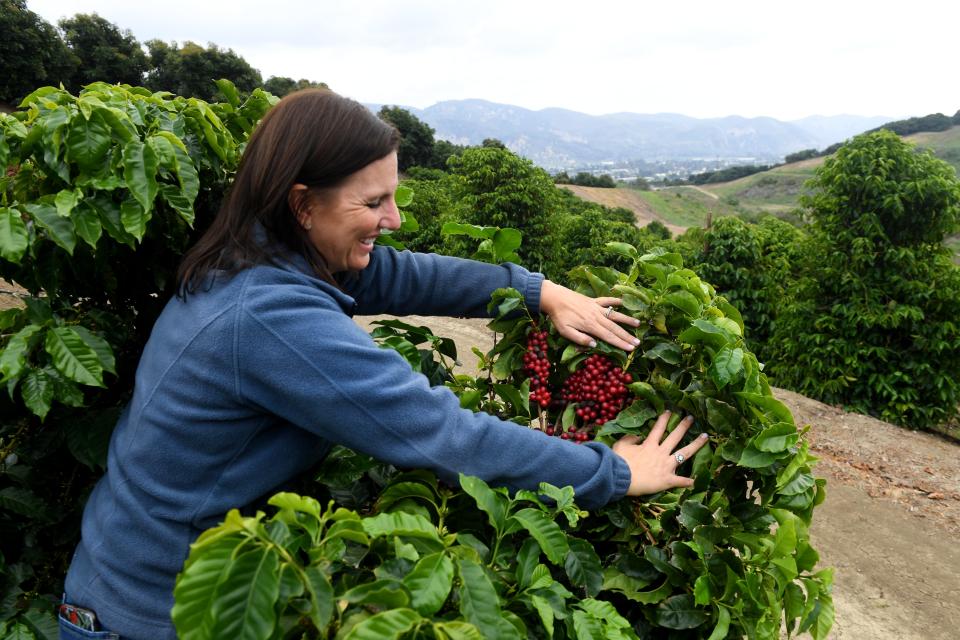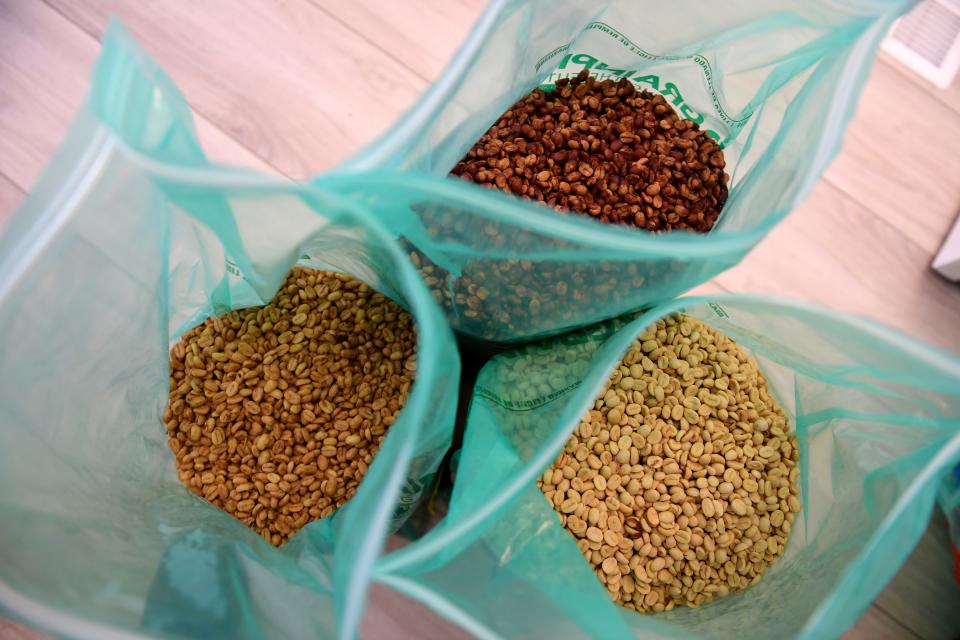Coffee revolution brewing among Ventura County farmers
A dusty, verdant smell hangs in a back room at Santa Paula's Rancho Filoso — like cut grass, touched with a nectarine sweetness.
Lisa Tate slides open a closet door. Piled inside are stacks of translucent green plastic bags, carefully labeled and dated like science experiments. She drags three out to the floor of the drying room and cracks their zippered seals. The smell billows forth, stronger.
The bags are full of coffee beans, green and fresh, still in their husks, grown right here on the slopes of Rancho Filoso.
Traditional wisdom has it that coffee is only a viable crop in the "bean belt" tropics: warm, humid locales like Hawaii, Brazil, Vietnam and coffee's homeland of Ethiopia.
But Ventura County farmers, and their counterparts in Santa Barbara and San Diego counties, are at the cutting edge of a growing revolution, trying to establish coffee as a new California cash crop.
More than 70 farms, including at least five in Ventura County, have begun growing coffee on a commercial scale.
The movement is still young and somewhat experimental, but already, California coffees are making a mark. Elika Liftee, a two-time U.S. Brewer's Cup gold medal winner and World Brewer's Cup runner-up, used beans from Goleta-based Frinj Coffee to place sixth at the national coffee-brewing competition in April.
Blue Bottle, one of the nation's largest specialty coffee roasters, has used California beans and on Wednesday, founder James Freeman opened a pop-up coffee tasting boutique in Los Angeles featuring more Frinj products.
Tate's Santa Paula beans scored a quality rating of 89.25 (out of 100) in taste tests three years ago, before her 1.5 acres of coffee trees were fully mature, and she's expecting this year's crop to perform even better.
"I've learned to be a coffee snob," said Tate, a former K-cup devotee. "We're not doing that. We're doing fancy schmancy."

Goleta origins
An organic farmer and agricultural tinkerer named Jay Ruskey grows his crops in the hills of Goleta.
Ruskey built his farm, Good Land Organics, around tropical fruits like cherimoya and finger limes. But in 2002, he met Mark Gaskell, a farm adviser with the University of California Agriculture and Natural Resources program.
Gaskell, who had previously worked in coffee hotspot Panama, convinced Ruskey to try growing coffee, and the farmer started interplanting his avocado groves with coffee seedlings.
Ruskey's coffee-growing experiments overlapped with what observers call the "third wave" of the U.S. coffee market: a movement toward coffee as a gourmet product, often roasted in house. The new wave adopted a lighter roasting style and highlighted the geographic origins of small batches of coffees.
With higher production and labor costs than the regions that grow most of the world's coffee, California is unlikely to ever compete with the low-end, bulk coffee grown on industrial-scale coffee farms. But the changing market, Ruskey said, opened a door for high-end California coffee to be profitable.
"The price points are still going up. The demand is global for specialty coffees," Ruskey said. "You can either make grape juice for Welch's or you can make wine."
And on his farm, Ruskey started to taste coffee he thought could meet that market demand.
Big money, big risk
In 2017, Ruskey founded Frinj, which has supplied plants and consultations to many of the new crop of commercial coffee farmers.
Those who want to sign on can pay Frinj for a farm consultation and then purchase trees that the farm grows from seed. Ruskey doesn't hesitate to reject farms he thinks don't have the proper terrain or weather.
When the first harvest is ready, Frinj processes the fresh coffee cherries at one of its two facilities in Goleta and San Diego County.
Ruskey said 30% to 40% of profits from the resulting green and roasted coffee goes back to the farmer. Frinj's roasted coffee can sell online for well over $100 per pound. Lemons retail for about $2 per pound, according to the US Department of Agriculture.
Today, Frinj's network has about 70 farms that Ruskey considers commercial scale, each with at least 500 plants. All told, he estimated, Frinj has sold over 100,000 trees to farmers.
To Ruskey's knowledge, it's the only operation of its kind outside the tropics. Farmers in Florida, Australia, Italy, Japan and South Africa are experimenting, he said, but not to Frinj's current scale.
Coffee plants can take four to five years to produce usable cherries and some of the farms in Frinj's network are still waiting for their plants to mature. Next year, Ruskey said, a number of those farms will produce their first harvests. He's anticipating Frinj's biggest harvest yet, well above the anticipated 1,000 pounds of green coffee the company anticipates this season.
Like some of his colleagues, David Armstrong, CEO of Hobson Family Farms, chose to sign on with Frinj two years ago in an attempt to diversify the farm's offerings.
Just three crops — avocados, lemons and strawberries — accounted for half of the county's $2.1 billion agriculture industry last year, according to the Ventura County Agricultural Commissioner's office.
There's risk in that top-heavy distribution. Factors like changing markets and new, crop-threatening pests can suddenly bite into the profitability of a single crop.
"I wanted to do something different," Armstrong said.
Hobson, located between Santa Paula and Ventura, planted roughly 13 acres with more than 18,000 coffee trees, making it Frinj's largest partner.
Armstrong expects his first viable crop next year and is "cautiously optimistic." Still, there are risks.
"We could lose our entire crop," he said. "There are huge unknowns. Every time it gets cold, we're facing losses. We don't know what the pest situations are."

Tate, who started out working with Frinj in 2016 before leaving because of distance issues and launching the California Coffee Collective, has already lost a number of trees.
"We lost plants to record-breaking heat, record-breaking winds," she said. This year, Rancho Filoso lost a cluster of trees when storm waters burst from a previously unknown spring in the middle of her orchard. "That's farming."
Ironically, the farm hasn't lost any trees to cold, the one thing Tate was most concerned about. She said climate change has made frosts rare in recent years.
Still, she said, coffee is "super experimental."
"It might not go," she said. "It could take one frost and it's done."
If the trees do survive for the long haul, there's the matter of growing coffee that is reliably delicious, a must for a crop targeting the high-end market.
"It's not just getting a crop," Armstrong said. "It's growing the best coffee in the world. It doesn't work (financially) otherwise."
Farmers are still tinkering, from seedling to green coffee bean. Ruskey said Frinj is working to dial in cultivation practices, especially since California growers are working under a different set of climate and terrain constraints from most of the rest of the world. Researchers from the University of California are also experimenting at sites in San Diego and Pomona.
Does the coffee taste better if it's grown in the shade or sun? What kind of nutrients do local soils need? How often should the plants be pruned? What varietals work best in local conditions?
With every plant taking years to mature, getting those answers isn't quick.
"I knew this was a long-haul process," said Ruskey, who doesn't expect the research to ever end.
"It's agriculture. Everyone's constantly trying to improve."
The cycle of experiments is faster once the coffee is picked.
Tate's California Coffee Collective, a partnership with Newbury Park-based Ragamuffin Coffee Roasters, has turned coffee cherries into syrups, candy brittle and a caffeinated jam packed with sweet, layered flavor. Tate said it goes well with brie cheese.
She said the collective has also supplied cherries — which would otherwise go to the trash heap — for liquor-distilling experiments at Ventura Spirits.
But the true gold is kept in a back closet at Rancho Filoso, packed into green plastic bags, carefully dated and labeled to keep track of the different processing methods the collective has experimented with.
Soon, it will be roasted, ground, steeped in hot water. Tate can't help but be excited.
"It's so obvious how special it is," she said.
Isaiah Murtaugh covers education for the Ventura County Star in partnership with Report for America. Reach him at isaiah.murtaugh@vcstar.com or 805-437-0236 and follow him on Twitter @isaiahmurtaugh and @vcsschools. You can support this work with a tax-deductible donation to Report for America.
This article originally appeared on Ventura County Star: Coffee revolution brewing among Ventura County farmers

